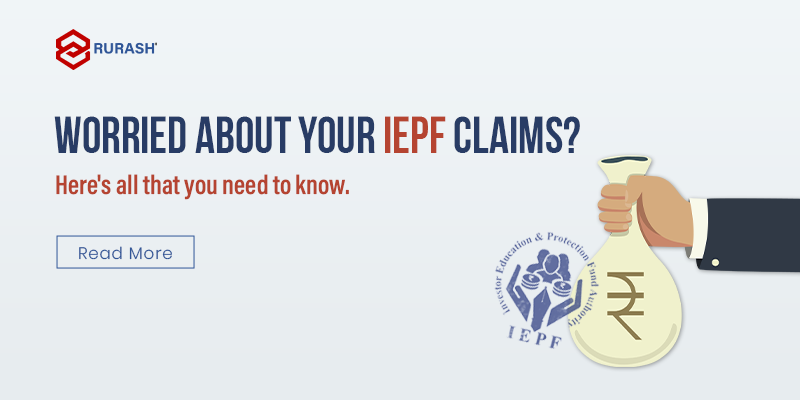If you’ve ever invested in the stock market, chances are you’re familiar with the term “IEPF” or Investor Education and Protection Fund. But have you ever wondered what happens to your shares if they remain unclaimed for a long time?
If the thought of navigating the IEPF claims process makes your head spin, worry not!
At Rurash Financials, we are here to help you ease this mountain of a task.
Let’s first break down everything you need to know about IEPF claims, from understanding the basics to checking and retrieving your unclaimed shares.
What is IEPF?
The Investor Education and Protection Fund (IEPF) is a government initiative aimed at safeguarding the interests of investors. It serves as a repository for unclaimed dividends, matured deposits, and shares, ensuring that investors do not lose their rightful dues. When shares, dividends, or other financial instruments remain unclaimed for a specified period, they are transferred to the IEPF for safekeeping, by the regulations laid down by SEBI and the Companies Act.
Why Do Shares End Up in IEPF?
Shares end up in IEPF for various reasons, such as the investor not claiming dividends or failing to update their details with the company. It’s crucial to stay informed about the status of your investments to prevent them from being transferred to IEPF.
When Shares are Transferred to IEPF
Before the transfer, investors are usually notified by the concerned company through various means, such as emails, letters, or public announcements, adhering to SEBI and Companies Act guidelines. It’s crucial to pay attention to these notifications and take immediate action to prevent the transfer of your assets to IEPF.
Reasons for Transfer to IEPF
Here are specific scenarios that lead to the transfer of assets to IEPF:
- Unclaimed Dividends: If a shareholder fails to claim their unclaimed dividend for seven years in a row, the dividend is transferred to the IEPF.
- Unclaimed Shares: If a shareholder does not claim their shares or rights for seven consecutive years, the shares are transferred to the IEPF.
- Inactive Accounts: In cases where a shareholder’s account has been inactive for seven years, and the company has been unable to contact the shareholder or their nominee, the shares are transferred to the IEPF.
- Dormant Companies: If a company has been dormant for seven years and failed to meet legislative requirements, such as holding annual general meetings and filing financial statements, its shares may be transferred to the IEPF.
Checking Your IEPF Status
Where to Begin?
To check whether your shares, dividends, or other financial assets have been transferred to IEPF, start by visiting the official website of the Investor Education and Protection Fund Authority (IEPFA). The website provides a user-friendly interface for investors to verify their IEPF status, following the guidelines.
Entering the Necessary Details
Once on the IEPFA website, navigate to the “IEPF Claim Status” section. You will be prompted to enter your Permanent Account Number (PAN) or Folio Number. Input the required details accurately, and the website will provide you with the current status of your shares, dividends, or other financial assets.
Initiating the Claim Process
Confirming Your Eligibility
Before initiating the claim process, ensure that you are eligible to reclaim your shares, dividends, or matured deposits from IEPF. Different guidelines apply to each category, so familiarise yourself with the regulations applicable to your situation.
Procedure to Claim Refund
- Access the IEPF-5 Webform: Please access the IEPF-5 webform for filing the claim for a refund. Read the instructions provided on the website/instruction kit along with the web form carefully before filling out the form.
- Form Submission and Acknowledgement: After filling out the form, submit the duly filled form. On successful submission, an acknowledgement will be generated indicating the SRN. Please note the SRN for future tracking of the form.
- Printout of Documents: Take a printout of the duly filled IEPF-5 and the acknowledgement issued after uploading the form.
- Submission of Documents: Submit the indemnity bond in original, a copy of the acknowledgement, and the IEPF-5 form along with the other documents as mentioned in Form IEPF-5 to the Nodal Officer (IEPF) of the company at its registered office in an envelope marked “Claim for refund from IEPF Authority.”
- Verification and Refund: Claim forms completed in all aspects will be verified by the concerned company. Based on the company’s verification report, the refund will be released by the IEPF Authority in favour of the claimants’ account through electronic transfer.
Common Challenges and Solutions
- Incorrect Details: One common challenge in the IEPF claims process is incorrect details. If your information doesn’t match the records, the claim might be rejected. Double-check and update your details with both the company and IEPF.
- Lack of Awareness: Many investors are unaware of the IEPF and the possibility of their shares, dividends, or matured deposits being transferred. Regularly monitor your investments, keep your contact information updated, and educate yourself about the IEPF to stay in the loop.
How can Rurash Financials help you?
Rurash Financials acts as your one-stop shop for claiming such unclaimed shares and handles it for you. Our team will guide you through claiming your IEPF unclaimed shares, including filing all documents and related formalities.
Understanding and reclaiming unclaimed shares, dividends, or matured deposits from IEPF might seem like a daunting task, but armed with the help of Rurash Financials experts’ knowledge and proactive measures, you can safeguard your investments and ensure you receive what’s rightfully yours.

